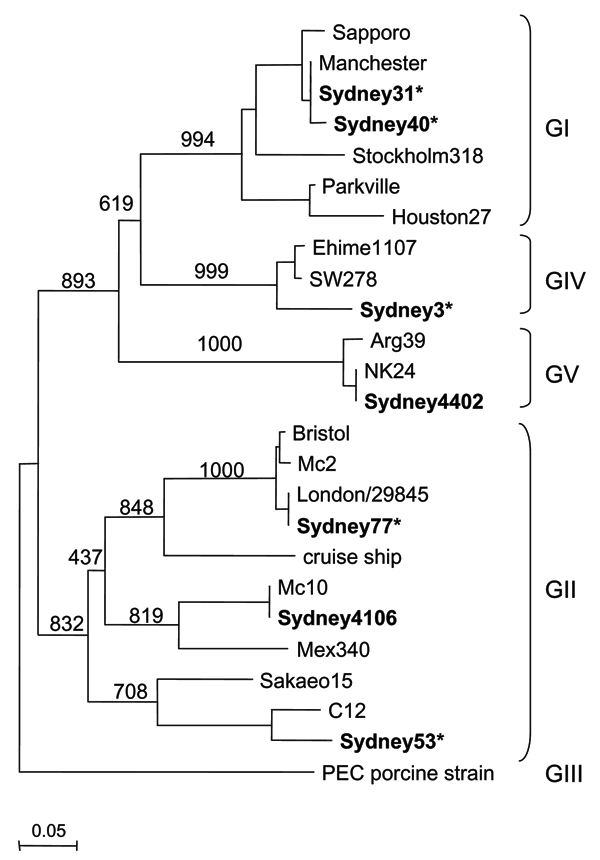Volume 12, Number 1—January 2006
Dispatch
Genetic Diversity of Sapovirus in Children, Australia
Figure

Figure. Phylogenic tree of Sapovirus (SaV) sequences isolated in this study (represented in boldface). SaV nucleotide sequences were constructed with the partial N-terminal capsid region, using SaV PEC strain (a porcine SaV) as an outgroup. The numbers on the branches indicate the bootstrap values for the clusters. Bootstrap values >950 were considered statistically significant for the grouping (8). Asterisks indicate specimens collected from outpatients. The distance scale in nucleotide substitutions per position is shown. Sydney isolates have been deposited in GenBank (accession nos. DQ104357–DQ104363). GenBank accession numbers for the reference strains are as follows: Arg39, AY289803; Bristol/98, AJ249939; C12, AY603425; cruise ship/2000, AY289804; Ehime1107, DQ058829; Houston/27/90, U95644; London/29845/90, U95645; Manchester, X86560; Mc2, AY237419; Mc10, AY237420; Mex340/1990, AF435812; NK24, AY646856; Parkville, U73124; PEC, AF182760; Sapporo/82, U65427; Stockholm/318/97, AF194182; Sakaeo15, AY646855; and SW278, DQ125333.
References
- Johansson PJ, Bergentoft K, Larsson PA, Magnusson G, Widell A, Thorhagen M, A nosocomial sapovirus-associated outbreak of gastroenteritis in adults. Scand J Infect Dis. 2005;37:200–4. DOIPubMedGoogle Scholar
- de Wit MA, Koopmans MP, van Duynhoven YT. Risk factors for norovirus, Sapporo-like virus, and group A rotavirus gastroenteritis. Emerg Infect Dis. 2003;9:1563–70.PubMedGoogle Scholar
- Hansman GS, Katayama K, Maneekarn N, Peerakome S, Khamrin P, Tonusin S, Genetic diversity of norovirus and sapovirus in hospitalized infants with sporadic cases of acute gastroenteritis in Chiang Mai, Thailand. J Clin Microbiol. 2004;42:1305–7. DOIPubMedGoogle Scholar
- Okada M, Shinozaki K, Ogawa T, Kaiho I. Molecular epidemiology and phylogenetic analysis of Sapporo-like viruses. Arch Virol. 2002;147:1445–51. DOIPubMedGoogle Scholar
- Farkas T, Zhong WM, Jing Y, Huang PW, Espinosa SM, Martinez N, Genetic diversity among sapoviruses. Arch Virol. 2004;149:1309–23. DOIPubMedGoogle Scholar
- Schuffenecker I, Ando T, Thouvenot D, Lina B, Aymard M. Genetic classification of “Sapporo-like viruses.”. Arch Virol. 2001;146:2115–32. DOIPubMedGoogle Scholar
- Katayama K, Miyoshi T, Uchino K, Oka T, Tanaka T, Takeda N, Novel recombinant sapovirus. Emerg Infect Dis. 2004;10:1874–6.PubMedGoogle Scholar
- Katayama K, Shirato-Horikoshi H, Kojima S, Kageyama T, Oka T, Hoshino F, Phylogenetic analysis of the complete genome of 18 Norwalk-like viruses. Virology. 2002;299:225–39. DOIPubMedGoogle Scholar
- Bull RA, Hansman GS, Clancy LE, Tanaka MM, Rawlinson WD, White PA. Norovirus recombination in ORF1/ORF2 overlap. Emerg Infect Dis. 2005;11:1079–85.PubMedGoogle Scholar
- Guntapong R, Hansman GS, Oka T, Ogawa S, Kageyama T, Pongsuwanna Y, Norovirus and sapovirus infections in Thailand. Jpn J Infect Dis. 2004;57:276–8.PubMedGoogle Scholar
- Kirkwood CD, Bishop RF. Molecular detection of human calicivirus in young children hospitalized with acute gastroenteritis in Melbourne, Australia, during 1999. J Clin Microbiol. 2001;39:2722–4. DOIPubMedGoogle Scholar
- Wright PJ, Gunesekere IC, Doultree JC, Marshall JA. Small round-structured (Norwalk-like) viruses and classical human caliciviruses in southeastern Australia, 1980–1996. J Med Virol. 1998;55:312–20. DOIPubMedGoogle Scholar
- Grohmann G, Glass RI, Gold J, James M, Edwards P, Borg T, Outbreak of human calicivirus gastroenteritis in a day-care center in Sydney, Australia. J Clin Microbiol. 1991;29:544–50.PubMedGoogle Scholar
- Kirkwood CD, Clark R, Bogdanovic-Sakran N, Bishop RF. A 5-year study of the prevalence and genetic diversity of human caliciviruses associated with sporadic cases of acute gastroenteritis in young children admitted to hospital in Melbourne, Australia (1998–2002). J Med Virol. 2005;77:96–101. DOIPubMedGoogle Scholar
- White PA, Hansman GS, Li A, Dable J, Isaacs M, Ferson M, Norwalk-like virus 95/96-US strain is a major cause of gastroenteritis outbreaks in Australia. J Med Virol. 2002;68:113–8. DOIPubMedGoogle Scholar
CrossRef reports the first author should be "Hugo Johansson" not "Johansson" in reference 1 "Johansson, Bergentoft, Larsson, Magnusson, Widell, Thorhagen, et al., 2005".